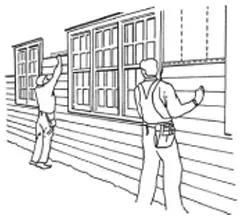The vinyl siding market is growing in leaps and bounds. However, installing vinyl siding can be a major undertaking for the uninitiated, and the best way to learn is hands-on experience. For most homeowners, a professional installation is recommended. Don’t hesitate to ask potential installers for license and certifications. Many manufacturers certify the contractors according to proper installation techniques. Also, ask for references and the names and numbers of satisfied customers.
But if you’re one of those “extreme” DIY’ers who feel up to the challenge, a great resource for installation guidance is the Vinyl Siding Institute. While manufacturers offer brand-specific installation manuals, the Vinyl Siding Institute offers a 40-page, detailed and illustrated installation manual that will give you a good look at what is involved. The manual contains the most recent techniques and is presented in a simple step-by-step approach. You can instantly download the installation manual for free by clicking here!

More Tips & Techniques for Vinyl Siding
Basic Installation Rules for Vinyl Siding
Before getting started, it is important to review several rules of thumb for vinyl siding application. The Vinyl Siding Institute offers the following rules for proper installation:
- Installed panels must move freely from side to side.
- When installing a siding panel, push up from the bottom until the lock is fully engaged with the piece below it. Without stretching the panel, reach up and fasten it into place.
- Fasten nails or other fasteners in the center of the nailing slot.
- Do not force the panels up or down when fastening in position.
- Do not drive the head of the fastener tightly against the siding nail hem. Allow 1/32 inch (about the thickness of a dime) clearance between the fastener head and the siding panel. Drive fasteners straight and level to prevent distortion and buckling of the panel.
- Leave a minimum of 1/4 inch clearance at all openings and stops to allow for normal expansion and contraction. When installing in temperatures below 40 degrees F, increase minimum clearance to 3/8 inch. A trim piece called the J-channel will cover the gap.
- Do not caulk the panels where they meet the receiver of inside corners, outside corners or J-trim. Do not caulk the overlap joints.
- Do not face-nail or staple through siding. Vinyl siding expands and contracts with outside temperature changes. Face-nailing can result in ripples in the siding.
- In residing, furring or removal of uneven original siding may be necessary.
Tips for Clapboard-Style Vinyl Sidiing




